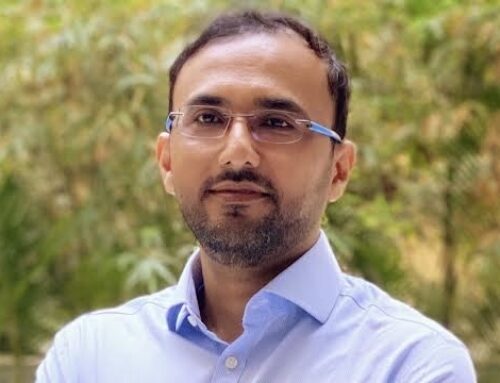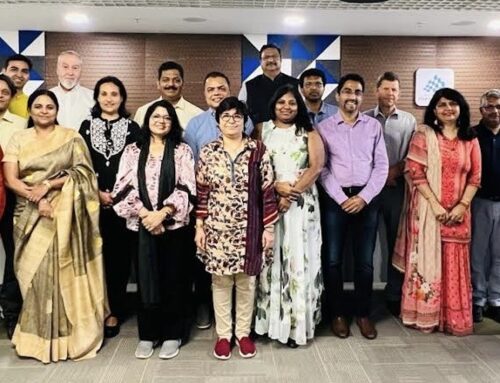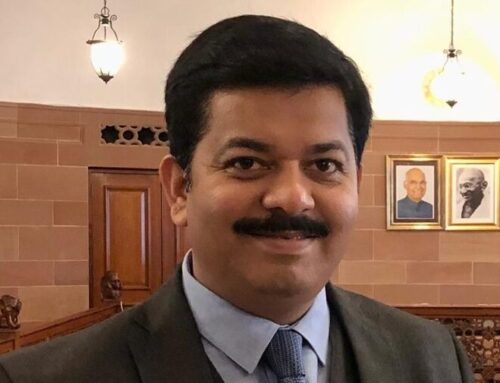John Hoffmire: One of the things that always impresses me when I sit down with a CRISP scholar is the interdisciplinary learning that each of you have engaged in. You are no exception. You’ve gone from a Bachelor of Engineering, to printing technology and graphic communication, technology management, Indology and Buddhist studies. Then on to consulting for Fortune 100 clients and working on emerging economy issues, and now heading business innovation at one of the largest technology companies. That’s a lot of diverse learning!
Sushrut: Well, my engineering degree has served me well in fields related to emerging markets and business innovation. The other master’s degrees have been useful in that they taught me critical thinking and essential research and analytic skills. I did the master’s degrees mostly because of my personal interest and love for the subjects. However, I also feel that studying the ancient cultures and philosophies give us an understanding of the society from the point of view of humanities and social sciences. This is more helpful for innovators that perhaps we realize, as most innovation, although powered by technology, always happens at the intersection of technology and humanities / social sciences. Never through technology alone. Studying history and ancient wisdom helps one understand and contextualize our present-day circumstances and challenges.
John: In our course work during the CRISP program, we talked a lot about disruptive innovation. I remember you gave an excellent example of how innovation happens in business and how innovation is often portable across industries even if the specific use cases are not. I realize that this question might not be incredibly clear to our readers. But I am sure that your answer will be intelligible.
Sushrut: I’ve often sited Apple’s iTunes business model as an innovation that revolutionized the music industry. All of its offerings, including the iPod and the iTunes store, appeared to have been crafted precisely for the music industry. But underlying these music-industry specific offerings was the real innovation – deconstructing the package (in this case a CD with 8 or more songs) into its constituents (songs) and allowing consumers to buy individual components, instead of forcing them to buy the entire package! This pattern was portable across multiple industries – and has indeed led to a lot of innovation. Smaller recharge plans for cellphones and small cold drink bottles, are examples of the same pattern applied to different industries. Other examples of this portability include ‘Uberization’, and the ‘Pre-paid services’ models.
John: You also have written about how incumbent corporations cannot innovate at the same pace as their disruptive counterparts. Digital disruptors outpace incumbent organizations when it comes to innovation, which can lead to obsolescence. Please tell me more about that.
Sushrut: Incumbent corporations are often the victims of their own success. They have a good business model that has historically worked well. As a result, there is organizational reluctance to change it. However, a key attribute of technology led innovation is that not only the number of competitors, but the nature of competitors can also change. Entire business models and products can become obsolete. Historical success is no guarantee of future success; in fact it has the risk of making the incumbents careless and complacent. I’ve used the example of Eastman Kodak as a lesson in what happens when you fail to innovate. Kodak was successful with a film business model that monetized the creation of memories. The “Kodak moment” became synonymous with events people wanted to capture and cherish. “You press one button and we do the rest,” said George Eastman, founder of Eastman Kodak. Any person who could operate a camera was capturing important moments in their lives. Yet cameras were not Kodak’s moneymakers. It was Kodak’s film and printing business model that made the company billions of dollars.
In 1975 Steve Sasson, an engineer at Kodak, invented the first digital camera. Unknowingly, Kodak invented the first domino that would start the disruption of its own business model. For the next three decades Kodak continued to release film and printing products. They began to sell printers and the Easyshare digital camera (but you still had to print the photos). Kodak even purchased Ofoto, a photo sharing website, but repurposed it for photo printing. They failed to see that film was being replaced by digital photos. Kodak declared bankruptcy in 2012.
Digital cameras replaced roll film cameras, and companies like Instagram became the new norm for photo sharing. Kodak did not act like their business model, which made them so successful, was going extinct. Kodak saw digital photography as a means to improve their printing business. They failed to adjust to the fact that sharing photos online had become the new and growing business.
John: Let me switch gears for a moment. What are some of the important lessons you’ve learned about business innovation?
Sushrut: Early on in my career and many times since I keep learning these two lessons: First, that is takes a lot of work to take an idea and turn it into an innovative product or service. The idea is just a starting point for innovation rather than the end goal. An innovation can only be called an innovation when it becomes useful to someone other than the inventor. A lot of work is required before a bright idea or invention can become an innovation. This is the art of systematic innovation. Technology forms an important, but small part of this process. The rest consists of understanding and factoring in nuances of the existing processes, talent, regulations, legacy systems and culture.
And second, I have learned and re-learned that popular culture is cluttered with the idea of genius innovators who have one great idea after another. In truth, innovation is a systematic discipline that can be learned and practiced. In fact, as Peter Drucker, the management guru, pointed out, “An innovation program based on the hopes of producing some bright ideas is the riskiest.”
John: While you were a CRISP scholar at Oxford, we talked a lot about innovation. Tell me about your time in Oxford, if you will.
Sushrut: From April to June 2013, I was invited to the University of Oxford by the UK government as a Chevening Fellow to participate in the Chevening Research Science and Innovation Leadership Programme (CRISP). The program was designed to bring together leading practitioners from Indian industry and government; and its goal was to introduce them to all things British: the research ecosystem, academic institutions, research collaboration processes, funding mechanisms, government, as well as to the British culture at large, with the intention of facilitating more Indo-UK collaborations in science and technology. I was one of 13 people invited from all over India across all industries. It was an extraordinary group to study and explore with and my time in the programme was truly transformative.
John: Thank you, Sushrut, It has been such a pleasure to catch-up with you and to learn about your work since you were at Oxford. I wish you continued success and learning.
Sushrut: Thank you, John. I wish the same for you and for the CRISP program. May it continue to be a force of interdisciplinary learning and transformation for years to come.
Read the entire interview here at The Center on Business and Poverty
Sushrut Vaidya is an Associate Vice President and Head of a Center for Emerging Technology Solutions for a major technology company
Interviewer: Dr. John Hoffmire is the Chairman of the Center on Business and Poverty, and Research Associate at the Oxford Centre for Mutual and Co-owned Business





